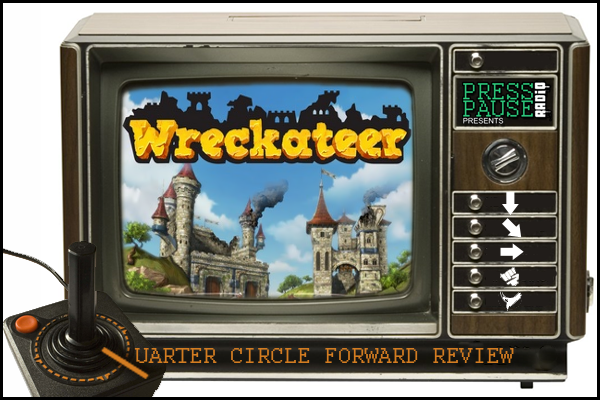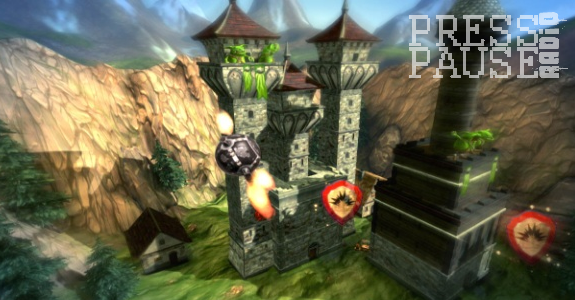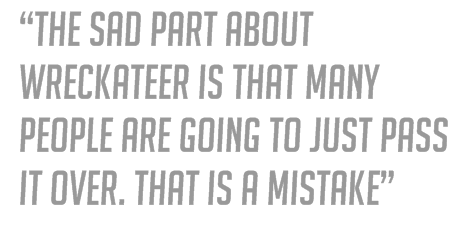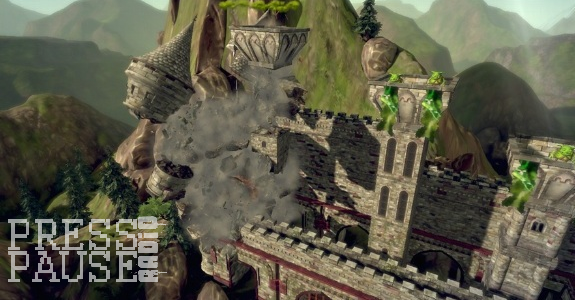QCF: Wreckateer

I went into Wreckateer with extremely low expectations. Given the abysmal showing the game had at E3 this year and the fact that it looked like an Angry Birds clone for Kinect, I was expecting to lazily flap my arms like a jackass while boulders broke stuff. After spending some time with Wreckateer, however, I began seeing how it's much more than just a clone of a cell phone game. In fact, this may be one of the better Kinect games on the Xbox that doesn’t require you to perform the Jersey Turnpike for bonus points.
Let’s go ahead and talk about the elephant in the room first. What makes or breaks Kinect games is whether or not the Kinect controls actually work. While not perfect by any stretch of the imagination, the movements required are easy to grasp and not overly complicated, and moving the shot in mid-air requires you to slap it. And then, depending on what type of ball you are using, they may have different abilities which are all activated with the same raised arm movement, which means you don’t need to memorize multiple movements for each different shot type. Again, the reading of your movements is not 100 percent; there will be times where you’re trying to move the ball downwards with a two hand slap, and might accidently activate the shot’s power.

Wreckateers only major low point is its aesthetic choice. Some people may like the goofy medieval fantasy setting, but it really kind of just annoys me. The constant lame jokes and wrecking puns make my eyes roll so hard that I feel like I’m going to snap my optic nerve. In fact, throw in a few fart jokes and you could easily call this game "Fable's Wreckateer."
 However, that's just me picking nits more than anyone else. This game scratches the same itch as Boom Blox, a game I really loved and one of the few games I thought was worth owning a Wii for. Basically, just launch some cannonballs and watch things go "boom." Wreckateer is that beautiful and wonderfully simple. You're graded on how much destruction you cause, obtaining medals at certain point values, and as you fling more orbs a multiplier bar fills up with more points. The replay value of this game is getting all of the gold medals, but even without that there are nine worlds, each with five stages, so there is plenty of content for the $15 price tag.
However, that's just me picking nits more than anyone else. This game scratches the same itch as Boom Blox, a game I really loved and one of the few games I thought was worth owning a Wii for. Basically, just launch some cannonballs and watch things go "boom." Wreckateer is that beautiful and wonderfully simple. You're graded on how much destruction you cause, obtaining medals at certain point values, and as you fling more orbs a multiplier bar fills up with more points. The replay value of this game is getting all of the gold medals, but even without that there are nine worlds, each with five stages, so there is plenty of content for the $15 price tag.
Adding to your destructive capabilities are the many different shot types and upgrade shields spread across the level. Some shots have an activated explosive, while others allow you to fly through the level. My favorite shot splits into four separate shots linked by a line of electricity. The shields hovering around the level allow you to apply other shot abilities to regular boulders, while adding additional points to your total score. The different types of shots must be used effectively to get maximum points. Use the explosive shots to knock down a clustered group of towers, or the bullet shot to blast through a line of buildings. Either way it adds a nice extra level of depth to the each shot you take.

Level designs also gets rather complex. At some points you'll use a flying shot to go off the path and grab some points shields, or use a lift shot to bounce over a building and reach one of those sweet, sweet towers. Levels are well designed and force you to make the most of your available shots. The challenge levels they have, one per world, also focus on a particular shot type, which help you hone your skills later on.
The sad part about Wreckateer is that many people are going to just pass it over. That is a mistake. It is one of the best games to come out of this year’s Summer of Arcade, and is one of the must-own games for your Kinect. I’m not saying this is "game of the year" material or anything, but that Wreckateer is a solid, fun destruction game with responsive controls, and it's worth the $15. Besides, if you have a Kinect, what else are you going to play? Kinect Star Wars? Rise of Nightmares? Come on, people.
Four out of Five Hadokens

 Indie Games,
Indie Games,  Kinect,
Kinect,  Summer of Arcade,
Summer of Arcade,  Wreckateer | in
Wreckateer | in  QCF Reviews
QCF Reviews 









